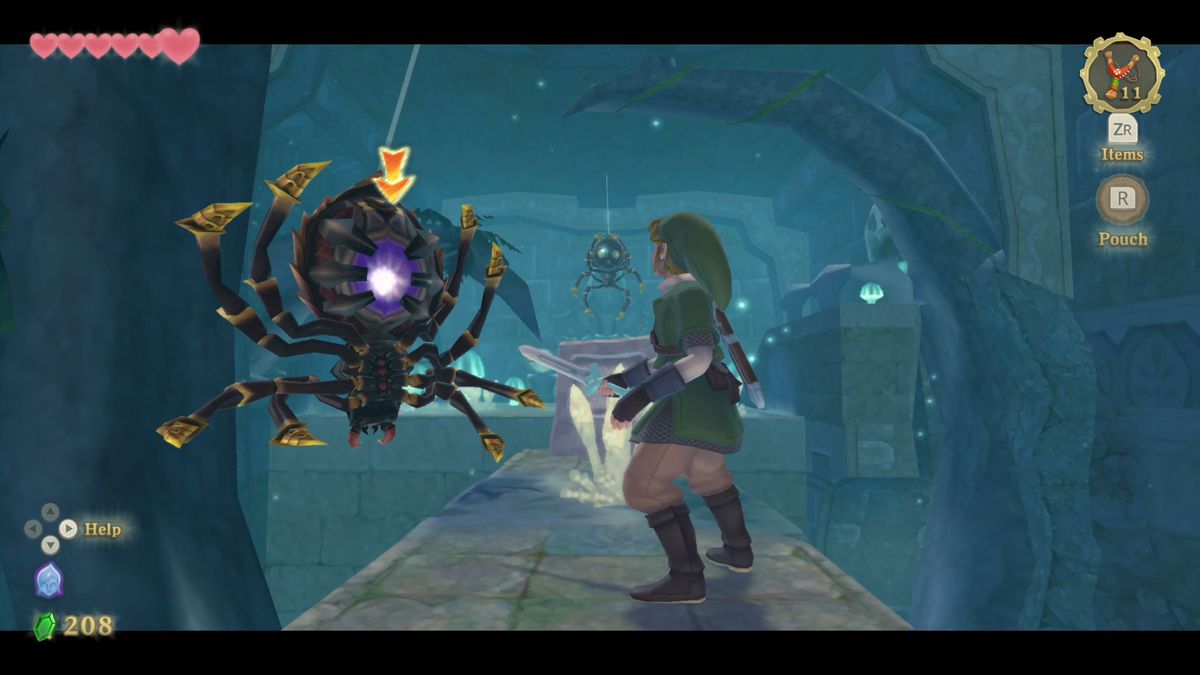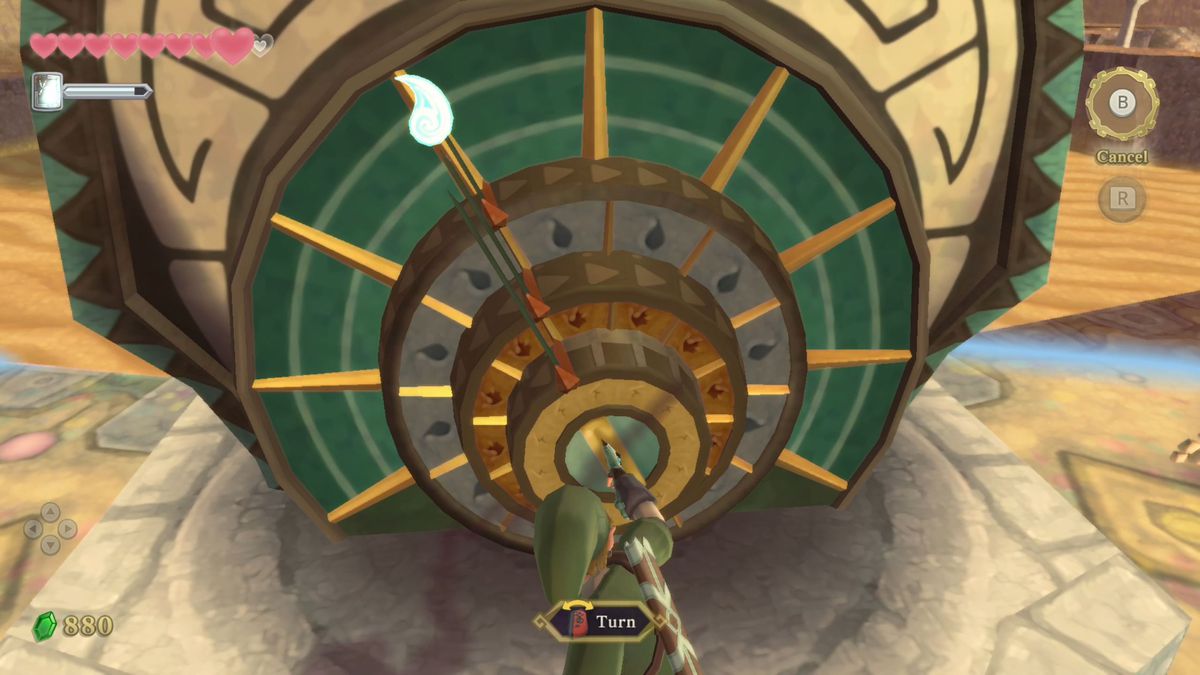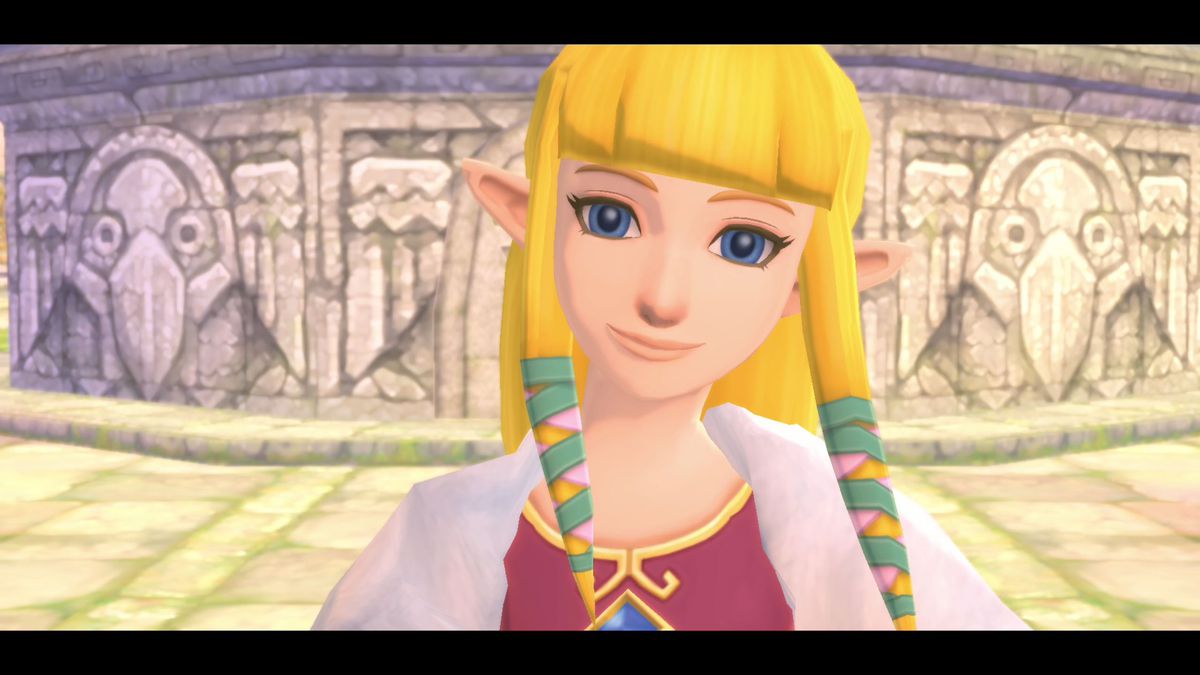It’s impressive how versatile a single analog stick can be.
That’s my biggest takeaway after playing 20 hours of the Nintendo Switch remaster of The Legend of Zelda: Skyward Sword. For its original 2011 release, the Zelda game was billed as having been built from the ground up for the Wii, using a special upgraded version of the console’s motion-controlled remote as the basis for its combat, exploration, and just about everything else. You can still see the remnants of that design philosophy in the game’s move to Switch, but after playing with both the motion-controlled Joy-Cons and the Pro Controller, it’s shocking how well Skyward Sword holds up — and how superfluous the motion controls feel, when they were the thing that defined the game back in 2011.
Back to that right analog stick. One of the biggest features of Skyward Sword, both the original and this version, is an eight-way slash system that lets Link attack enemies from different angles. Originally, the player had to swipe their Wii remote in the corresponding direction. The right analog stick takes care of that now. It also handles camera control, aiming with weapons like the Slingshot and Gust Bellows, throwing bombs (both over and underhand, which is relevant in some puzzles), playing the Goddess’ Harp, and pulling off the spin move that gives you a speed boost while swimming. It’s a lot. And the analog stick handles it all really, really well.

Image: Nintendo via Polygon
The eight-way slash system made combat in Skyward Sword feel a little dopey at times; enemies like to tuck their weapons close to their face defensively all the time, so you have to slash at them in specific directions. But you know what? It’s fun having to watch a Deku Baba to see whether it’s going to open its mouth sideways or vertically, then line up the correct attack in response. Now that I use the analog stick, combat feels a lot sharper, and I like the directional variation more than just mashing a single attack button during every encounter.
Directing attacks with the right analog stick also feels more precise than swiping my controller. And even if the Joy-Con’s motion controls are better than the original Wiimote, I don’t think I actually want The Legend of Zelda to map all of my movements to the screen. Playing with Joy-Cons, I realized I had a habit of doing diagonal slashes when I had intended to do right-to-left ones. That’s really my fault, but I think I’d rather have the game approximate my analog motions than accurately track me flailing my hands.
It’s not just combat that feels better with the right analog stick. In the fourth dungeon, the Ancient Cistern, you get a whip, and if you’re using the Joy-Cons, you’ll need to flick them to crack the whip. I did that a few times, flicking switches and turning knobs with Link’s new weapon. But then, when I switched back to the Pro Controller, I felt cooler using the right analog stick to do those same things. Using that whip to dismantle a huge golden idol with six arms, then laying into it with its own giant swords felt just as satisfying without having to swing my hand around. I didn’t miss the motion controls at all.
That’s kind of a big deal. A TV commercial for the Wii version of Skyward Sword implied the Wii remote would create a stronger connection between players and the iconic Master Sword and Hylian Shield. The game required an accessory called the Wii Motion Plus, which improved the motion-tracking capabilities of the remote. If there was going to be a game that proved the Wii’s whole schtick could improve Nintendo’s biggest franchises, this was going to be it. To see that pitch get completely nullified by a single analog stick (OK, two: You parry with your shield using the left analog stick) makes me look back and laugh at an entire generation of games that had motion controls duct-taped to them just because they were on the Wii. Thinking back on it, I think Wii Sports and WarioWare: Smooth Moves are the only games that wouldn’t work without motion controls. All of the console’s other best original games have been proven to work just as well without them.

Image: Nintendo via Polygon
Still, Skyward Sword was designed around the Wii Remote, and you can still see that design philosophy here in ways that feel strange with a regular controller. Take, for example, the Goddess Walls. If you see butterflies near a wall, you play the Harp by flicking the right analog stick back and forth. That reveals the hidden Goddess Wall, on which you then draw a symbol, whether it’s a circle to get bombs or a heart to get heart pieces, using the analog stick. There’s also the dowsing mechanic, which has you searching for key items by going into first-person and pinpointing them like you’re using radar. It’s pretty obvious these are only here to take advantage of the Wii remote, and without that, they feel needless and out of place.
It wasn’t just the motion controls that made Skyward Sword divisive, though. The game’s other defining trait in 2011 was how plodding and linear its early portions were. Critics lambasted the game for tutorializing every little thing at length, having your helper spirit Fi point out the obvious over and over again in her robotic little voice. At one point, you spend a few minutes listening to an incredibly loud snoring noise as you climb The Great Tree, only for Fi to stop you in your tracks near the end to ask, “Do you hear that?”
Playing through Skyward Sword now, the early hours of the game seem like they weren’t just about the Wii’s new controller, but its new audience. The Wii expanded gaming’s audience to include people who had never played a game before, so Nintendo built a Zelda game with them in mind. That meant explaining a lot of things, reinforcing those explanations multiple times, and toning down the challenge a notch. So, of course veterans were going to roll their eyes.
The remaster does alleviate some of that by making sure you don’t have to read item descriptions and making Fi’s butting-in less frequent, but it doesn’t solve every problem. It still takes quite a while to get into the thick of the game. Exploring a little bit in the early sections of Skyloft as Link passes his final exam to become a knight and start his quest to save Zelda took about an hour and a half. In 2011, this was another knock against a series that had become too concerned with its story at the cost of the immediacy of earlier games in the series. But in 2024, in the wake of Breath of the Wild opening up a new round of speculation about Zelda lore, and the marketing for its upcoming sequel doubling down on the connection between the former two games, Skyward Sword’s intro is much more fascinating.

Image: Nintendo via Polygon
More importantly, after that slow start, I finally got to the sections that made me fall in love with Skyward Sword 10 years ago, from the cast of characters and the interplay between them, to the dungeons, which have stuck in my mind as some of (if not the) best in the series. Again, the game starts out slow; Skyview Temple is maybe the simplest Zelda dungeon in history, and the Earth Temple is good but nothing notable. From the third dungeon on, though, Skyward Sword employs a stellar combination of outside puzzle areas and indoor dungeons.
Think of Skyward Sword as the “Oops! All Dungeons!” Zelda. There’s not a ton of room to explore; instead, the game uses its limited space to iterate on puzzle concepts. The Lanayru Desert and Mining Facility are early standouts. You’ll combine two of your previous items (bombs and the new beetle item) to create a bomber drone, contend with a time-shifting mechanic that forces you to think about spaces across two eras, and get the Dust Bellows item that lets you move platforms and sand. It’s a lot for one dungeon, and it’s a delight.
I know there are some real momentum killers coming up in the rest of my playthrough of Skyward Sword, like the Silent Realm sections, or swimming around to collect musical notes. But there are also some high points that remain for me to re-experience, like the last two dungeons. I’ll see how those have held up over time; I’ll share more in my full review once I’ve beaten the game. Maybe they’re not as good as I remember, but at least I won’t have to waggle my way through them this time.
The Legend of Zelda: Skyward Sword HD will be released July 16 on Nintendo Switch. The game was reviewed on Nintendo Switch using a pre-release download code provided by Nintendo. Vox Media has affiliate partnerships. These do not influence editorial content, though Vox Media may earn commissions for products purchased via affiliate links. You can find additional information about Polygon’s ethics policy here.
Polygon – All
Source link
Related Post:
- Skyward Sword HD Motion Controls Are Good Actually
- The Legend of Zelda: Skyward Sword HD is the fourth Zelda to reach No.1 | UK Boxed Charts
- UK: The Legend of Zelda: Skyward Sword HD is No.1 and fourth No.1 for the Zelda series
- Cosplay Wednesday – The Legend of Zelda: Skyward Sword’s Zelda
- Valheim’s community-made VR mod now has motion controls • Eurogamer.net
- Mario Golf: Super Rush update releasing today – Ranked Match, Toadette, New Donk City, improved motion controls
- Suda51 Talks No More Heroes 3, Switch Motion Controls And More
- Skyward Sword HD is Pleasant, But Hindered by Its Controls
- The Legend of Zelda: Skyward Sword HD Overview Trailer Released
- The Legend of Zelda: Skyward Sword HD Quality of Life Improvements Detailed
